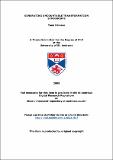Generating uncountable transformation semigroups
Abstract
We consider naturally occurring, uncountable transformation semigroups S and investigate the following three questions.
(i) Is every countable subset F of S also a subset of a finitely generated subsemigroup of S? If so, what is the least number n such that for every countable
subset F of S there exist n elements of S that generate a subsemigroup of S
containing F as a subset.
(ii) Given a subset U of S, what is the least cardinality of a subset A of S such
that the union of A and U is a generating set for S?
(iii) Define a preorder relation ≤ on the subsets of S as follows. For subsets V and
W of S write V ≤ W if there exists a countable subset C of S such that V
is contained in the semigroup generated by the union of W and C. Given a
subset U of S, where does U lie in the preorder ≤ on subsets of S?
Semigroups S for which we answer question (i) include: the semigroups of the injec-
tive functions and the surjective functions on a countably infinite set; the semigroups
of the increasing functions, the Lebesgue measurable functions, and the differentiable
functions on the closed unit interval [0, 1]; and the endomorphism semigroup of the
random graph.
We investigate questions (ii) and (iii) in the case where S is the semigroup Ω[superscript Ω] of all functions on a countably infinite set Ω. Subsets U of Ω[superscript Ω] under consideration
are semigroups of Lipschitz functions on Ω with respect to discrete metrics on Ω and
semigroups of endomorphisms of binary relations on Ω such as graphs or preorders.
Type
Thesis, PhD Doctor of Philosophy
Collections
Items in the St Andrews Research Repository are protected by copyright, with all rights reserved, unless otherwise indicated.

